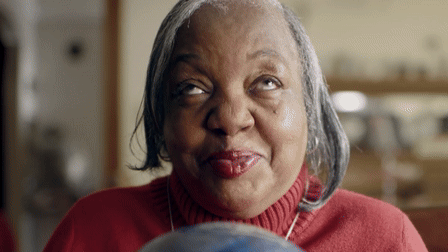
Save this storySave this storySave this storySave this story
The filmmakers were moved by the resilience displayed by the three women whose lives they observed and the other bowlers.
On Friday nights, Judy, Sandy, and Rhonda head to Burnham Bowl, in the Milwaukee suburb of West Allis. The three friends take part in the Milwaukee Beer Barrels Blind Bowling League—a rowdy mix of fully sighted and visually impaired participants. Bowlers have the option of using a guiding rail as they approach the lane, and they are as devoted to feisty trash talk and lively dancing as they are to hitting the pins.
The short film “Friday Night Blind,” directed by Scott Krahn and Robb Fischer, offers a snapshot of the three friends’ lives, from their raucous nights at the bowling alley to in-home interviews with the women, capturing intimate glimpses of their activities and hobbies, and the adaptive technologies they sometimes use. Judy demonstrates her barcode scanner, which helps her identify miscellaneous items by reading out the product names, and a bill reader that recognizes different banknotes. Rhonda uses her talking book player to read, and knits with the aid of a color identifier for her yarn. Sandy plays the accordion, uses a Perkins Brailler to write, and shows off her collections of souvenir magnets from her travels and of noise-making clocks. Other hobbies require some degree of collaboration. Judy mentions that, in their spare time, she and Sandy love to cook together, visit the mall, or just chat. “We sit on the phone, run our mouth,” she says.
The New Yorker Documentary
View the latest or submit your own film.

A 2016 study revealed that Americans regarded blindness as the worst ailment they could potentially experience, worse than AIDS, Alzheimer’s disease, cancer, limb loss, or deafness. Judy reminisces about things she could do before losing her sight—like motorcycle riding—but the women’s lives are fun, and full. “You can live your life, just like everybody else. You may have to do things in a different way, and there’s really no right way or wrong way to do it,” Sandy says. “You just learn to do things the way that works out for you.”
In making the film, Fischer and Krahn were moved by the resilience displayed by the women and the other bowlers dealing with varying degrees of visual impairment. “I just fell in love with not only those three ladies but just everybody in that league,” Fischer said. Krahn added, “They are living life to the fullest. They don’t let their disabilities get in the way, and they’re really good people. They’re generous. I think that’s just a good guide for all of us, because sometimes we get all worked up about little things that really don’t matter.”
The tally of the scores fades into the background at their Friday sessions. “My best game ever was last year. I bowled a 128. My worst game, I bowled a zero,” Rhonda says. Judy reflects on her own prowess: “I don’t bowl that good. It go wherever it want to go—might give me a pin and might give me a gutter. But I did it, hear me?”
Sourse: newyorker.com